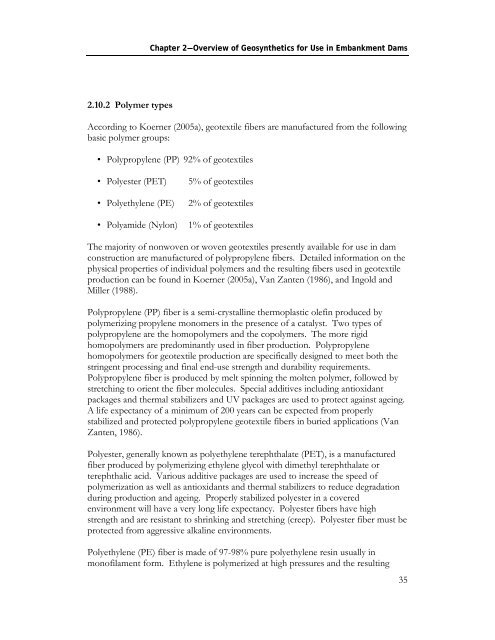Geotextiles in Embankment Dams - Association of State Dam Safety ...
Geotextiles in Embankment Dams - Association of State Dam Safety ...
Geotextiles in Embankment Dams - Association of State Dam Safety ...
You also want an ePaper? Increase the reach of your titles
YUMPU automatically turns print PDFs into web optimized ePapers that Google loves.
Chapter 2—Overview <strong>of</strong> Geosynthetics for Use <strong>in</strong> <strong>Embankment</strong> <strong><strong>Dam</strong>s</strong>2.10.2 Polymer typesAccord<strong>in</strong>g to Koerner (2005a), geotextile fibers are manufactured from the follow<strong>in</strong>gbasic polymer groups:• Polypropylene (PP) 92% <strong>of</strong> geotextiles• Polyester (PET)• Polyethylene (PE)• Polyamide (Nylon)5% <strong>of</strong> geotextiles2% <strong>of</strong> geotextiles1% <strong>of</strong> geotextilesThe majority <strong>of</strong> nonwoven or woven geotextiles presently available for use <strong>in</strong> damconstruction are manufactured <strong>of</strong> polypropylene fibers. Detailed <strong>in</strong>formation on thephysical properties <strong>of</strong> <strong>in</strong>dividual polymers and the result<strong>in</strong>g fibers used <strong>in</strong> geotextileproduction can be found <strong>in</strong> Koerner (2005a), Van Zanten (1986), and Ingold andMiller (1988).Polypropylene (PP) fiber is a semi-crystall<strong>in</strong>e thermoplastic olef<strong>in</strong> produced bypolymeriz<strong>in</strong>g propylene monomers <strong>in</strong> the presence <strong>of</strong> a catalyst. Two types <strong>of</strong>polypropylene are the homopolymers and the copolymers. The more rigidhomopolymers are predom<strong>in</strong>antly used <strong>in</strong> fiber production. Polypropylenehomopolymers for geotextile production are specifically designed to meet both thestr<strong>in</strong>gent process<strong>in</strong>g and f<strong>in</strong>al end-use strength and durability requirements.Polypropylene fiber is produced by melt sp<strong>in</strong>n<strong>in</strong>g the molten polymer, followed bystretch<strong>in</strong>g to orient the fiber molecules. Special additives <strong>in</strong>clud<strong>in</strong>g antioxidantpackages and thermal stabilizers and UV packages are used to protect aga<strong>in</strong>st age<strong>in</strong>g.A life expectancy <strong>of</strong> a m<strong>in</strong>imum <strong>of</strong> 200 years can be expected from properlystabilized and protected polypropylene geotextile fibers <strong>in</strong> buried applications (VanZanten, 1986).Polyester, generally known as polyethylene terephthalate (PET), is a manufacturedfiber produced by polymeriz<strong>in</strong>g ethylene glycol with dimethyl terephthalate orterephthalic acid. Various additive packages are used to <strong>in</strong>crease the speed <strong>of</strong>polymerization as well as antioxidants and thermal stabilizers to reduce degradationdur<strong>in</strong>g production and age<strong>in</strong>g. Properly stabilized polyester <strong>in</strong> a coveredenvironment will have a very long life expectancy. Polyester fibers have highstrength and are resistant to shr<strong>in</strong>k<strong>in</strong>g and stretch<strong>in</strong>g (creep). Polyester fiber must beprotected from aggressive alkal<strong>in</strong>e environments.Polyethylene (PE) fiber is made <strong>of</strong> 97-98% pure polyethylene res<strong>in</strong> usually <strong>in</strong>mon<strong>of</strong>ilament form. Ethylene is polymerized at high pressures and the result<strong>in</strong>g35
















